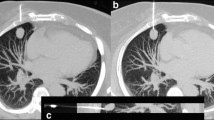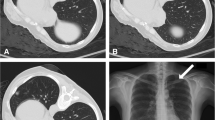Abstract
Purpose
The aim of this study was to analyse factors predicting the diagnostic accuracy of computed tomography (CT)-guided transthoracic fine-needle aspiration (TTFNA) for solid noncalcified, subsolid and mixed pulmonary nodules, with particular attention to those responsible for false negative results with a view to suggesting a method for their correction.
Materials and methods
From January 2007 to March 2010, we retrospectively reviewed the CT images of 198 patients of both sexes (124 males and 74 females; mean age, 70 years; range age, 44–90) used for the guidance of TTFNA of pulmonary nodules. Aspects considered were: lesion size and density, distance from the pleura, and lesion site. Multiplanar reformatted images (MPR) were retrospectively obtained in the sagittal and axial oblique planes relative to needle orientation.
Results
The overall diagnostic accuracy of TTFNA CTguided biopsy was 86% for nodules between 0.7 and 3 cm, 83.3% for those between 0.7 and 1.5 cm, and 92% for those between 2 and 3 cm. Accuracy was 95.1% for solid pulmonary nodules, 84.6% for mixed nodules, and 66.6% for subsolid nodules. The diagnostic accuracy of CT-guided TTFNA in relation to the distance between the nodule and the pleural plane was 95.6% for lesions adhering to the pleura and 83.5% for central ones. The diagnostic accuracy was 84.2% for the pulmonary upper lobe nodules, 85.3% for the lower lobe and 90.9% for those in the lingula and middle lobe. In 75% of false negative and inadequate/insufficient cases the needle was found to lie outside the lesion, after reconstruction of the needle path by MPR.
Conclusions
The positive predictive factors of CT-guided TTFNA are related to the nodule size, density and distance from the pleural plane. The most common negative predictive factor of CT-guided TTFNA is the wrong position of the needle tip, as observed in the sagittal and axial oblique sections of the MPR reconstructions. The diagnostic accuracy of CT-guided TTFNA can therefore be improved by using the MPR technique to plan the needle path during the FNA procedure.
Riassunto
Obiettivo
Scopo del presente lavoro è stato individuare ed analizzare i fattori che predicono l’accuratezza diagnostica dell’ago-biopsia trans-toracica (TTFNA) guidata da tomografia computerizzata (TC) dei noduli polmonari solidi non calcifici, subsolidi e misti, con particolare attenzione ai fattori responsabili di falsi negativi, proponendo un metodo per la loro correzione.
Materiali e metodi
Tra il 2007 ed il 2010 sono state analizzate retrospettivamente le immagini TC del torace di 198 pazienti di entrambi i sessi (124 maschi e 74 femmine, età media 70 anni, range età 44–90) utilizzate per l’esecuzione di TTFNA TC-guidata di noduli polmonari. I criteri analizzati sono stati: dimensione, densità, distanza dal piano pleurico e sede dei noduli polmonari. Sono state ottenute retrospettivamente immagini in ricostruzioni multiplanari (MPR) sui piani sagittali ed asssiali obliqui in relazione all’orientamento dell’ago.
Risultati
L’accuratezza complessiva della TTFNA TC-guidata per noduli polmonari compresi tra 0,7 e 3 cm è stata 86%. L’accuratezza per i noduli polmonari compresi tra 7 e i 15 mm è stata del 83,3%, per quelli compresi tra 20 e 30 mm del 92%. L’accuratezza per i noduli polmonari solidi è stata del 95%, per i noduli misti 84,6% e per noduli subsolidi 66,6%. L’accuratezza per i noduli adesi al piano pleurico è stata del 95,6% e per quelli centrali 83,5%. Per i noduli dei lobi superiori è stata 84,2%, per quelli dei lobi inferiori 85,3%, per quelli della lingula e del lobo medio 90,9%. Nel 75% dei casi falsi negativi, inadeguati o insufficienti, la punta dell’ago dopo ricostruzione MPR era localizzata all’esterno o in periferia del nodulo polmonare.
Conclusioni
I fattori diagnostici predittivi positivi della TTFNA TC-guidata sono correlati con le dimensioni, la densità e la distanza del nodulo polmonare con il piano pleurico. Il fattore predittivo negativo ricorrente della TTFNA TC-guidata è l’errata localizzazione della punta dell’ago, mal evidente nelle scansioni assiali native, osservata retrospettivamente nelle sezioni sagittali ed assiali oblique MPR. Il ricorso alle immagini MPR sagittali e assiali oblique durante l’agoaspirazione è utile per il corretto planning della traiettoria dell’ago, quest’ultimo aspetto cruciale che influenza l’accuratezza diagnostica della procedura.
Similar content being viewed by others
References/bibliografia
Layfield LJ, Coogan A, Johnston WW, Patz EF (1996) Transthoracic fine needle aspiration biopsy. Sensitivity in relation to guidance technique and lesion size and location Acta Cytol 40:687–690
Larscheid RC, Thorpe PE, Scott WJ (1998) Percutaneous transthoracic needle aspiration biopsy: a comprehensive review of its current role in the diagnosis and treatment of lung tumors. Chest 114:704–709
Westcott JL, Rao N, Colley DP (1997) Transthoracic needle biopsy of small pulmonary nodules. Radiology 202:97–103
Swischuk JL, Castaneda F, Patel JC et al (1998) Percutaneous transthoracic needle biopsy of the lung: Review of 612 lesions. J Vasc Interv Radiol 9:347–352
Myrna C, Godoy, David P et al (2009) Subsolid pulmonary nodules and the spectrum of peripheral adenocarcinomas of the lung: recommended interim guidelines for assessment and management. Radiology 253:606–622
Tarver RD, Conces DJ (1994) Interventional chest radiology. Radiol Clin North Am 32:689–709
Boiselle PM, Shepard JAO, Mark EJ et al (1997) Routine addition of an automated biopsy device to fine-needle aspiration of the lung: a prospective assessment. AJR Am J Roentgenol 169:661–666
Arslan S, Yilmaz A, Bayramgürler B et al (2002) CT-guided transthoracic fine needle aspiration of pulmonary lesions: Accuracy and complications in 294 patients. Med Sci Monit 8:493–497
Kim HK, Shin BK, Cho SJ et al (2002) Transthoracic fine needle aspiration and core biopsy of pulmonary lesions. A study of 296 patients. Acta Cytol 46:1061–1068
Laurent F, Latrabe V, Vergier B et al (2000) Percutaneous CT-guided biopsy of the lung: Comparison between aspiration and automated cutting needles using a coaxial technique. Cardiovasc Intervent Radiol 23:266–272
Swischuk JL, Castaneda F, Patel JC et al (1998) Percutaneous transthoracic needle biopsy of the lung: Review of 612 lesions. J Vasc Interv Radiol 9:347–352
Kothary N, Lock L, Sze DY, Hofmann LV (2009) Computed tomographyguided percutaneous needle biopsy of pulmonary nodules: impact of nodule size on diagnostic accuracy. Clin Lung Cancer 10:360–363
Klein JS, Salomon G, Stewart EA (1996) Transthoracic needle biopsy with a coaxially placed 20-gauge automated cutting needle: results in 122 patients. Radiology 198:715–720
Austin JHM, Cohen MB (1993) Value of having a cytopathologist present during percutaneous needle aspiration biopsy of lung: report of 55 cancer patients and metaanalysis of the literature. AJR Am J Roentgenol 160:175–177
Nizzoli R, Tiseo M, Gelsomino F et al (2011) Accuracy of fine needle aspiration cytology in the pathological typing of non-small cell lung cancer. J Thorac Oncol 6:489–493
Stewart CJ, Stewart IS (1996) Immediate assessment of needle aspiration cytology of lung. J Clin Path 49:839–843
Westcott JL (1988) Percutaneous transthoracic needle biopsy. Radiology 169:593–601
Shiau MC, Bonavita J, Naidich DP (2007) Adenocarcinoma of the lung: current concepts in radiologic diagnosis and management. Curr Opin Pulm Med 13:261–266
Van Sonnenberg E, Lin AS, Deutsch AL, Mattrey RF (1983) Percutaneous biopsy of difficult mediastinal, hilar, and pulmonary lesions by computed tomographic guidance and a modified coaxial technique. Radiology 148:300–302
Stanley JH, Fish GD, Andriole JG et al (1987) Lung lesions: cytologic diagnosis by fine-needle biopsy. Radiology 162:389–391
Khouri NF, Stitik FP, Erozan YS et al (1985) Transthoracic needle aspiration biopsy of benign and malignant lung lesions. AJR Am J Roentgenol 144:281–288
Li H, Boiselle PM, Shepard JO et al (1996) Diagnostic accuracy and safety of CT-guided percutaneous needle aspiration biopsy of the lung: comparison of small and large pulmonary nodules. AJR Am J Roentgenol 167:105–109
Tsukada H, Satou T, Iwashima A, Souma T (2000) Diagnostic accuracy of CT-guided automated needle biopsy of lung nodules. AJR Am J Roentgenol 175:239–243
Perlmutt LM, Johnston WW, Dunnick NR (1989) Percutaneous transthoracic needle aspiration: a review. AJR Am J Roentgenol 152:451–455
Kazerooni EA, Lim FT, Mikhail A, Martinez FJ (1996) Risk of pneumothorax in Ct-guided transthoracic needle aspiration biopsy of the lung. Radiology 198:371–375
Rizzo S, Preda L, Raimondi S et al (2011) Risk factors for complications of CT-guided lung biopsies. Radiol Med 116:548–563
Shimizu K, Ikeda N, Tsuboi M et al (2006) Percutaneous CT-guided fine needle aspiration for lung cancer smaller than 2 cm and revealed by ground-glass opacity at CT. Lung Cancer 51:173–179
Patrick M, Johannes B David E et al (2003) Towards complete and accurate reporting of studies on diagnostic accuracy: the STARD initiative. Clinical Chemistry 49:1–6
Charig M J, Phillips AJ (2000) CTguided cutting needle biopsy of lung lesions: safety and efficacy of an outpatient service. Clin Radiol 55:964–969
Kim TJ, Lee JH, Lee CT et al (2008) Diagnostic accuracy of CT-guided core biopsy of ground-glass opacity pulmonary lesions. AJR Am J Roentgenol 190:234–239
Afify A, Davila RM (1999) Pulmonary fine needle aspiration biopsy: assessing the negative diagnosis. Acta Cytol 43:601–604
Salazar A, Westcott JL (1993) The role of transthoracic needle biopsy for the diagnosis and staging of lung cancer. In: Matthay RA (ed). Clin Chest Med 14:99–110
De Filippo M, Onniboni M, Rusca M et al (2008) Advantages of multidetectorrow CT with multiplanar reformation in guiding percutaneous lung biopsies. Radiol Med 113:945–953
Bozzetti C, Naldi N, Nizzoli R et al (2013) Reliability of EGFR and KRAS mutation analysis on fine-needle aspiration washing in non-small cell lung cancer. Lung Cancer 80(1):35–38
Author information
Authors and Affiliations
Corresponding author
Rights and permissions
About this article
Cite this article
De Filippo, M., Saba, L., Concari, G. et al. Predictive factors of diagnostic accuracy of CT-guided transthoracic fine-needle aspiration for solid noncalcified, subsolid and mixed pulmonary nodules. Radiol med 118, 1071–1081 (2013). https://doi.org/10.1007/s11547-013-0965-4
Received:
Accepted:
Published:
Issue Date:
DOI: https://doi.org/10.1007/s11547-013-0965-4
Keywords
- Lung nodule
- Multiplanar reformatting
- MPR
- Trans-thoracic fine needle aspiration, TTFNA
- CT-guided biopsy
- Predictive diagnostic factors




